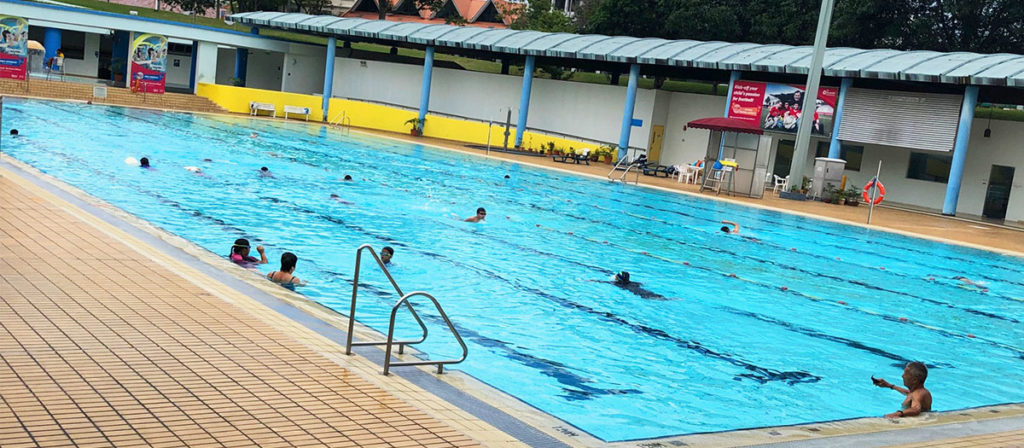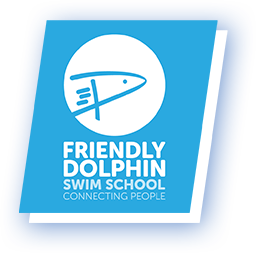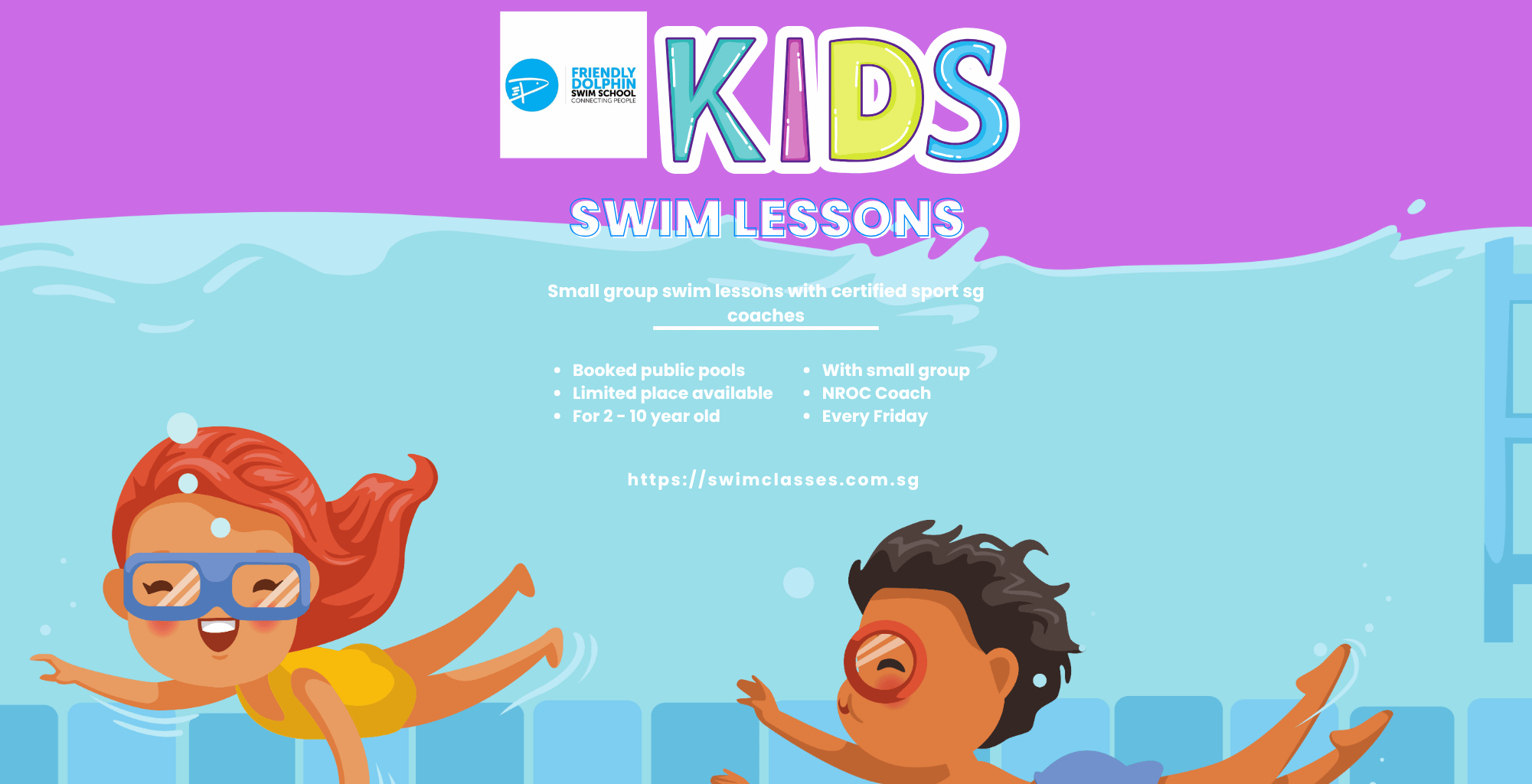Where to Learn Swimming in Singapore?

Are you looking to learn swimming in Singapore?
Swimming lessons are conducted in private swimming pools such as condominiums, clubhouses, or public swimming complexes in Singapore.
There are a total of 26 public swimming pools spread around on every corner of Singapore.
Sport Singapore manages all public swimming complexes. Operation timing is generally longer than private pools, and some start their morning swim as early as 6.30 am.
However, at times public swimming complexes might be overcrowded. So try to do some research and check on the availability of swimming lessons before committing to the classes.
Public swimming complexes include:
- Heartbeat@Bedok Swimming Complex
- Hougang Swimming Complex
- Tampines Hub Swimming Complex
- Pasir Ris Convention Centre Swimming Complex
- Toa Payoh Swimming Complex
- Sengkang Swimming Complex
- Bukit Batok Swimming Complex
- Jurong East Swimming Complex
- Jurong West Swimming Complex
- Serangoon Swimming Complex
- Choa Chu Kang Swimming Complex
- and more
Private swimming pools include all private condominiums and clubhouses:
- Chinese swimming club
- Orchid country club
- Seletar country club
- Safra Tampines
- Safra Mount Faber
- Safra Yishun
- Safra Punggol
Learning to Swim in Singapore?
Swimming lessons in Singapore generally start at around 8.30 am in Singapore. Kids group classes are controlled under Sport Singapore for a group of 10 kids per group.
Adult swimming classes generally start after age 16 and is capped at 10 adults per group as well.
Individual to group classes from 1:1 to 1:10 is the most common groupings for swimming classes in Singapore.
The duration of the swimming classes varies depending on the group size, age, and attention span of the students. Swimming classes usually last 30 mins for toddlers and babies, 45 mins to 60 mins for kids five years old and above.
How Long Should a Lesson Last?
Age and attention span is the determining factor of how long a lesson should be. The length of the swimming lessons is critical for the development of the swimmers.
Generally, the younger the students are, the shorter the duration of swimming lessons due to the shorter attention span (there is always an exception). I would not recommend students below the age of 4 to have swimming lessons longer than 15 minutes.
However swim school usually stretched the time to 30 minutes for age four and below, while putting in time for breaks and covering different skills.
The fees structure for swimming lessons as follows:
Read more: Swimming Lessons Fee
Swimming lessons are no different from other education classes. The learning takes place based on instructions, self-discovery, practices, and repetitions of swimming drills.
Swimming teachers in Singapore help students better understand the rhythmic movements of swimming, how to make use of water for efficiency, and swimming more effectively.
Correct Swimming Techniques
Swimming is the same as running, we need to have thrust force to move forward. When we run, we plant our foot on the ground and our body continues to go forward fighting against resistance of air.
With swimming, however, you need to learn and make progress with the body traveling forward over the hand. In order to learn good swimming, we must always keep in mind “forward motion.”
We need to be able to hold more water with our hands to pull our bodies further “forward.”
To hold more water, your hands and legs need to be able to understand the slow to fast motion. Some people will even liken “the action” to pushing a heavy ball back and then flinging it behind you for every leg and hand stroking action.
For front crawl, butterfly stroke and backstroke, this action is applicable to hand action.
For survival backstroke and breaststroke, this action is applicable to the leg action.
Always think long when you are in the water. Reach and stretch out as far as you can with your pulling arms and leg kicking action. Make yourself long and as stretched as much as possible in the water.
Swimming experts know how to integrate land drills, easy-to-follow progressive practices in developing your understanding of the strokes such as:
- Front Crawl
- Breaststroke
- Backstroke
- Butterfly
- Survival Backstroke
Learn Swimming With Experts
Swimming is taught by some of the competitive swimming instructors in the public swimming complex. Swimming fast relies a lot on using a good body position to fight against the water resistance.
It is preferable to find coaches with NROC of a level 2 to guide you on competitive swimming.
Read more: Competitive Swimming Lessons
Students will be taught water resistance and how to overcome or leverage it in swimming and competitive swimming lessons.
Swimmers use his whole body to push through the water. Water-resistance is the force of water that pushes them back. Leverage or reduce the water-resistance and students will swim much faster.
Swimming lessons are generally conducted outdoor in swimming complex and private condominiums.
People of all ages learn swimming in Singapore, and swimming is one sport with almost no impact on practice by all ages.
Swimming provides a multitude of lifetime benefits (mental and physical) well being.
It is one of the most popular forms of exercise, but most people do not swim well enough to reap the benefits.
Learning swimming with experts will better enable you to start a new era of relations with the water. Swimming instructors will guide the “right way”. The basics of awareness, direction, and balance are at the heart of every good swimming stroke.
You will be taught to master it, develop a series of repetitions of aquatic skills required for a healthier and more pleasurable style of swimming.
Certifications and Swimming
There are three kinds of certifications that are issued in Singapore to prove swimming proficiency. These certifications can be later used to waive off the compulsory ten swimming lessons when the students reach the primary three levels.
They are:
- Swimsafer Certifications offered under Sport Singapore
- SSTA Certifications offered under Singapore Swimming Association
- AUSTSWIM International Certificates offered by Australian Swim Institute

The above chart is for competitive swimming proficiency test international practice within FINA. Singapore syllabus for standard swimming proficiency is covered under Swimsafer 2.0 instead.
Beginners start from level 1 and progress gradually to the most advanced at swim safer gold (Level 6).
Read more: Swimsafer 1
Learn Swimming in Singapore VS Learn Swimming Overseas
There are a total of 26 public swimming pools in Singapore. Usually, people who learned swimming from overseas will do so in the pools built by the swim schools.
This is, however, not practiced in Singapore. Swimming pools are built conveniently in Singapore at different locations for swimming lessons.
Overseas swim training tends to be affected by the seasonal changes of countries. Singapore is a sunny island with occasional raining; swimming lessons can be conducted all day long in Singapore.
“Right” or “Good” Swimming Instructor?
A “right” or “good” swimming instructor matters?
Different people learn in different swimming styles; that’s why it is often correlated to find one that is right and good to fit in.
It is often wise to find out about the instructor’s way of teaching, his cues, his experiences, his knowledge, and skills before committing.
“Good” instructors might sometimes not fit into your learning style, so finding the right fit is always better.
Every approach is different, but the stages of progression should remain the same.
Do you need to learn how to crawl before you walk?
Always make sure that your instructors start off by teaching you good breathing techniques, followed by floating before going into more technical actions like leg and arm action, etc.
Rules for Appropriate Swim Attires

Wear appropriate swimwear at all-time in the public swimming complex.
Have your body covered in swimwears that block out harmful sun UV rays is essential when it comes to swimming outdoors.
Also, put up some sunscreen lotion as appropriate to prevent any sunburn from staying out too long out in the sun.


